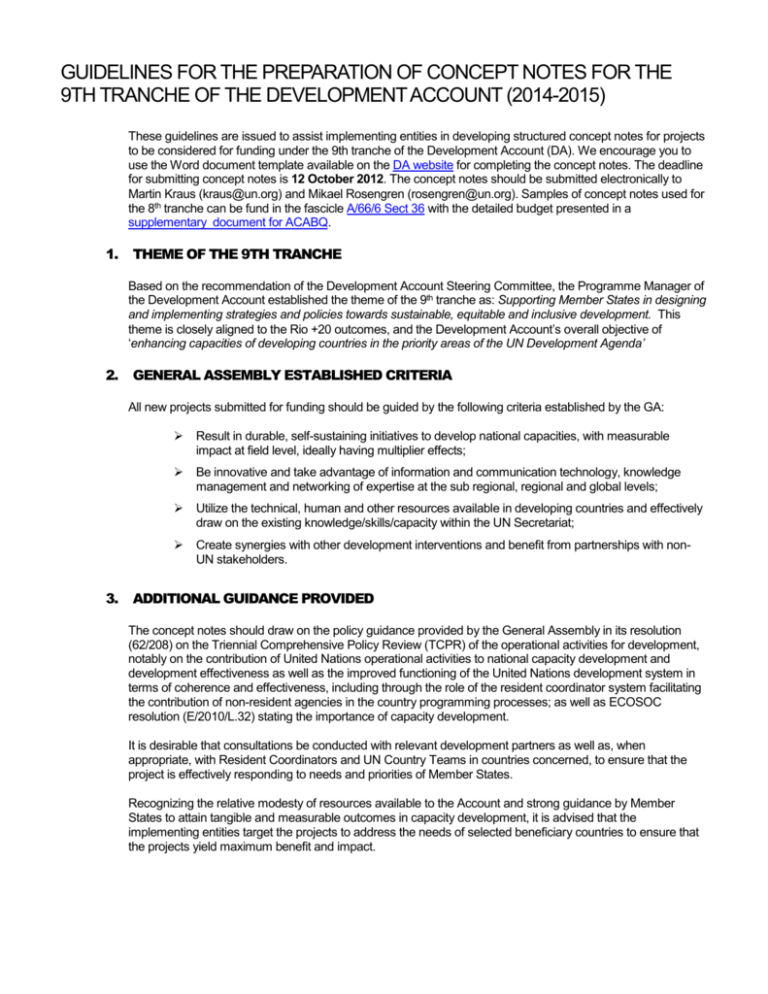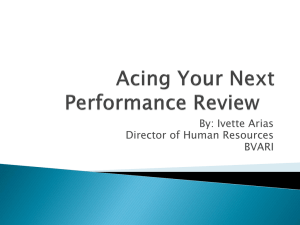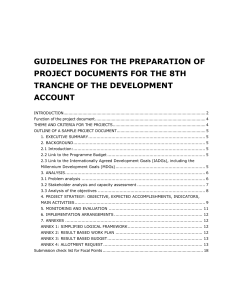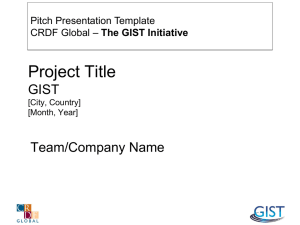9th tranche concept - the United Nations
advertisement

GUIDELINES FOR THE PREPARATION OF CONCEPT NOTES FOR THE 9TH TRANCHE OF THE DEVELOPMENT ACCOUNT (2014-2015) These guidelines are issued to assist implementing entities in developing structured concept notes for projects to be considered for funding under the 9th tranche of the Development Account (DA). We encourage you to use the Word document template available on the DA website for completing the concept notes. The deadline for submitting concept notes is 12 October 2012. The concept notes should be submitted electronically to Martin Kraus (kraus@un.org) and Mikael Rosengren (rosengren@un.org). Samples of concept notes used for the 8th tranche can be fund in the fascicle A/66/6 Sect 36 with the detailed budget presented in a supplementary document for ACABQ. 1. THEME OF THE 9TH TRANCHE Based on the recommendation of the Development Account Steering Committee, the Programme Manager of the Development Account established the theme of the 9th tranche as: Supporting Member States in designing and implementing strategies and policies towards sustainable, equitable and inclusive development. This theme is closely aligned to the Rio +20 outcomes, and the Development Account’s overall objective of ‘enhancing capacities of developing countries in the priority areas of the UN Development Agenda’ 2. GENERAL ASSEMBLY ESTABLISHED CRITERIA All new projects submitted for funding should be guided by the following criteria established by the GA: 3. Result in durable, self-sustaining initiatives to develop national capacities, with measurable impact at field level, ideally having multiplier effects; Be innovative and take advantage of information and communication technology, knowledge management and networking of expertise at the sub regional, regional and global levels; Utilize the technical, human and other resources available in developing countries and effectively draw on the existing knowledge/skills/capacity within the UN Secretariat; Create synergies with other development interventions and benefit from partnerships with nonUN stakeholders. ADDITIONAL GUIDANCE PROVIDED The concept notes should draw on the policy guidance provided by the General Assembly in its resolution (62/208) on the Triennial Comprehensive Policy Review (TCPR) of the operational activities for development, notably on the contribution of United Nations operational activities to national capacity development and development effectiveness as well as the improved functioning of the United Nations development system in terms of coherence and effectiveness, including through the role of the resident coordinator system facilitating the contribution of non-resident agencies in the country programming processes; as well as ECOSOC resolution (E/2010/L.32) stating the importance of capacity development. It is desirable that consultations be conducted with relevant development partners as well as, when appropriate, with Resident Coordinators and UN Country Teams in countries concerned, to ensure that the project is effectively responding to needs and priorities of Member States. Recognizing the relative modesty of resources available to the Account and strong guidance by Member States to attain tangible and measurable outcomes in capacity development, it is advised that the implementing entities target the projects to address the needs of selected beneficiary countries to ensure that the projects yield maximum benefit and impact. 4. TIMELINE 27 July 2012: Programme Manager requested Implementing Entities to submit concept notes 12 October 2012 Deadline for submitting concept notes End November 2012 Development Account Programme Management Team (DA PMT) presents the short list of projects to be funded from the DA to the Steering Committee for review and endorsement. The Programme Manager subsequently approves the list based on the recommendation of the Steering Committee November December 2012 DA PM Team submits the concept notes to the Review Group, for quality assurance processes, and works with implementing entities to finalize concept notes as part of the budget fascicle December 2012 Programme Manager submits draft fascicle to PPBD December 2012 to February 2013 DA PM Team together with PPBD finalizes the DA section of the Proposed Programme Budget 2014-2015 May/June 2013 Administrative Committee for Administrative and Budget Questions (ACABQ) reviews the fascicle Summer/Fall 2013 Implementing Entities prepare project documents based on the concept notes using internal quality assurance mechanisms. Starting in October DA PMT is available to review project documents Fall 2013 Fifth Committee considers the fascicle End of December 2013 GA will finalize its consideration of the Programme Budget and make a decision on its approval and appropriation of funds April 2014 Deadline for submission of project documents to DA PMT September 2014 Deadline for issuance of allotments December 2017 Projects are expected to have been successfully completed 2/6 5. MAIN ELEMENTS OF THE CONCEPT NOTES Concept notes need to include the following elements (template is available on the DA website), i. Title ii. Implementing entity and partners iii. Background iv. Relationship to the Strategic Framework for the period 2014-2015 and the Millennium Development Goals v. Objective vi. Expected accomplishments vii. Indicators of achievement viii. Main activities ix. Budget narrative These components are expanded on below: i. Title The title should reflect the main programmatic thrust of the project. It should be short, concise, one sentence long and include an indication as to who will be the main beneficiaries, including the geographical scope of the project, and what capacities will be strengthened. The scope of the project should be realistic and commensurate with the project’s budget. Elements of titles normally include: Strengthening of capacities of (beneficiaries) in (countries / sub-regions / regions) on (substance of the project). ii. Implementing entity and partners This section should list the implementing entities starting with the main entity. Normally the partners are UN Secretariat entities and in some cases other UN funds and programmes, if they have a major role to play. Concept notes which involve collaboration and/or cooperation with other UN Secretariat partners should be shared, with them, for comments and agreement, in principle, to participate. iii. Background: The background needs to be concise and describe the (a) development issue that the project intends to address. This section should spell out what are the capacity assets, needs and priorities of the target countries which the project intends to work with, and emphasize the demand emanating from these countries. (b) It should refer to the most recent intergovernmental legislation in this area and the mandate which calls for action. When relevant, it should make reference to how the activities respond to Rio+20 outcomes. (c) This section should explain how the project fits with the overall normative and analytical work of your Department, and detail your comparative advantages in this area. (d) It should highlight lessons learned and achievements from earlier projects in the area, when applicable. (e) It should elaborate on the implementation arrangements with project partners within the UN Secretariat and with the broader UN System and funds and programmes and specialized agencies, where appropriate. iv. Relationship to the Strategic Framework for the period 2014-2015 and the Millennium Development Goals (MDGs): The section should provide a reference to the relevant expected accomplishment(s) of the concerned sub programmes of the Strategic Framework for the period 2014-2015 (please include it for all UN Secretariat partners). This section should indicate which MDG(s) the project intends to contribute to. Example: Economic and social affairs subprogramme 8 (Public administration and development management); Millennium Development Goal 8. 3/6 v. Objective: The objective is the overall intended goal of the project. The project’s delivery will contribute to the attainment of the objective, but may not be fully achieved during the implementation period of the project. It should be concise, not longer than one sentence; it should include the beneficiaries and the geographical scope and should not attempt to explain how the implementing entity intends to go about achieving the objective, ie should not include ‘through’. There should be only one objective. Examples of objectives include: to increase national / local government capacity to identify/ apply/ develop…; to improve the formulation of national/ local policies on…; to increase the knowledge of public officials and development practitioners on…. vi. Expected accomplishments (EA): The EAs describe the desirable future conditions of the individual stakeholders or institutional changes of partner organizations or the society as a whole that can be reasonably attributed to or associated with the project. Expected accomplishments should be achievable within the project timeframe and budget, and specific enough to be measured by the associated indicators of achievement. A clear distinction should be made between the expected accomplishments (results) and the activities utilized for achieving each of them. The activities are the means that should result in the achievement of one expected accomplishment. There should be a maximum of three expected accomplishments that contribute to the achievement of the objective. Examples of expected accomplishments include: increased levels of knowledge and awareness of…; increased skills in…; increased understanding of…; establishment of a network to…; improved organization of…; adoption of international measures of…. vii. Indicators of achievement: The indicators of achievement are measures used to determine to what extent the expected accomplishments have been achieved. Indicators help determine the progress made towards meeting the stated achievements. An expected accomplishment may have more than one indicator. There are no absolute principles about what makes a good indicator of achievement; however the SMART characteristics listed below are useful: Specific: indicators need to be specific and to relate to changes in conditions of beneficiaries that can reasonably be attributed to or credibly be associated with the Development Account Measurable: both quality and quantity indicators are useful. Quantifiable indicators are preferred because they are precise and can in some cases be aggregated; Achievable and attainable: the indicator must be attainable within the timeframe of the project and at reasonable cost; Realistic and relevant: indicators should be relevant to the management information needs of stakeholders and project managers; Time bound: should be measurable within the timeframe of the project. Many projects use indictors measuring outcomes of training activities. These indicators should not measure only the number of people trained. Instead they should aim at measuring how participants or their organizations use the skills and knowledge gained to achieve the specific goals set out at the workshops, like for example action plans created, legislations drafted, methodologies developed. Examples of indicators include: increased number of national/ local personnel able to identify/ apply/develop…; increased number of project countries/ institutions utilizing; national policy or strategy documents reflecting (substance of the project); increased number of countries developing action plans or executing action plans 4/6 viii. Main activities: Main activities are actions to be taken to achieve the expected accomplishments. Well-formulated activities should answer the question, “What are the best specific actions that need to be taken by the project team, in cooperation with the beneficiaries, to achieve the expected accomplishments?” Examples of main activities include: workshops/seminars; publications; training modules and advisory services. Each activity should have a code that clearly links it to the expected accomplishment it contributes to, i.e. A1.3 contributes to EA1. Logical Framework The four elements outlined above (objective, expected accomplishments, indicators and main activities) need to be clearly linked through a logical framework, which build on each other. In order to ascertain the validity of the logical framework, a top down and bottom up review should be conducted. Top down questions: 1. How can the objective be met? …By achieving the expected accomplishments. 2. How can the expected accomplishments be achieved? ..By delivering the main activities. Bottom up questions: 1. If the project delivers the main activities, will they contribute to achieving the expected accomplishments? 2. If the project achieves the expected accomplishments, will this help meeting the objective? ix. Budget narrative: The funding envelope of the 9th tranche is established at $29.3 million.. It is expected that about 45 projects will be funded under the 9th tranche, with an average budget of $650,000 per project. The funding distribution among the implementing entities will be in line with past tranches. Projects which involve more than two implementing entities may have higher budgets, while staying within the overall budget allocation of the participating entities. The projects should make use of existing human resources capacities within the implementing entities. In light of this guidance from the intergovernmental process, the use of General Temporary Assistance (GTA) and consultancies should be limited. Whenever feasible, national and regional consultants should be used to draw on local knowledge and expertise and to promote sustainability in the country. The same applies to the use of contractual services with local and regional institutions and/or NGOs to support selected activities of the projects. At least two percent of the total budget needs to be allocated for the final evaluation. The eight budget categories used to prepare the concept paper are: a. General temporary assistance GTA is to be used to assist in administrative matters and backstopping of limited substantive tasks through recruitment of temporary staff normally to be placed within the entity implementing the project. As the projects are to be implemented largely with existing human resources, GTA should be of a limited duration. The Development Account does not fund staff positions. b. Consultants A distinction should be made between international consultants and national/regional consultants. The proposed budget should provide details on the purpose(s) of the consultants, and a breakdown of fees, and their related travel. Resource persons, such as panellists at meetings, workshops and seminars should be budgeted under consultancies and not under workshops. A minimum of 2% should be budgeted for the final external evaluation of the project. 5/6 c. Expert group Meetings Expert groups meetings (EGMs) are organized to provide expert advice to the implementing entity e.g. in the context of finalizing methodologies, studies etc. EGMs are not intended to be used for strengthening knowledge and/ or developing skills of the participants from the target countries. If the main purpose of a meeting is to transfer knowledge and skills to the target countries (including government official and national experts) then such a meeting should be budgeted under workshops. If experts to an EGM receive a fee for services provided in the context of the EGM such costs should be budgeted under consultancies. d. Travel of staff This budget line should be used for all staff travel against the project (participation in expert groups, workshops, and provision of advisory services). The project should foresee (and allocate) funds for travel of UN staff from the implementing partners, if it is a part of the implementation plan. Travel of UN staff should not be budgeted under workshops or EGMs. e. Contractual services Contractual services are used for institutional contracts with NGOs, national or regional institutions or commercial providers for specialised inputs to the project such as preparing and printing publications, organizing certain project activities, through subcontract or grant arrangements, etc. The use of local and regional institutions and/or NGOs, when it can facilitate the delivery of the project, is seen as a good practice. f. Operating expenses Operational expenses are for covering costs of postage, communications, in-house or low-value printing of reports, etc. More significant printing jobs should, however, be budgeted under contractual services. Given that the Development Account is funded from the UN regular budget activity, most operating costs should normally be covered from the entities’ general allocations. g. Equipment and supplies This line should pay for office equipment, software and supplies to be provided to the target countries when necessary. h. Seminars, workshops and study tours The seminars and workshops line should be used for training and skills enhancement activities. It covers costs related to the travel and DSA of workshop participants, rental of the workshop venue and local conference-related expenditures, including interpretation and translation services (if the venue is non-UN). However, if the organization of the training activity is subcontracted to an institute, the cost should be charged to contractual services. Travel of staff for workshops needs to be budgeted under travel of staff. Travel of resource persons substantively contributing to workshops, who also receive fees, should be budgeted under consultants. Study tours are visits of sites and institutions in one or more selected countries to observe development activities, gather information and exchange experience with host counterparts. Under this budget line, covering costs of travel of participants to UN events and meetings should be limited only to specific cases where such participation clearly contributes to the achievement of the expected accomplishments of the project. Proposed expenditures under each budget line should be supported by a brief, easy-to-understand narrative providing details of the purpose and basic scope of activities involved. See template available on the DA website for details. 6/6





